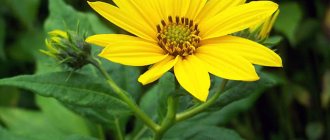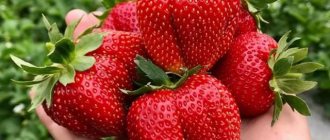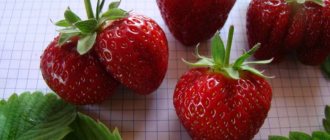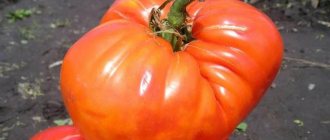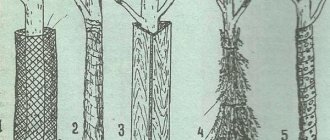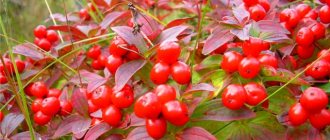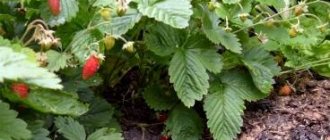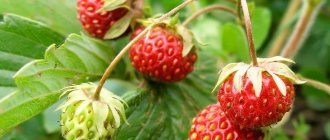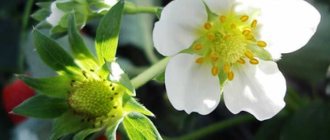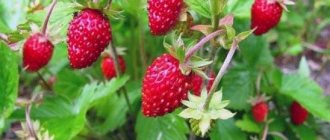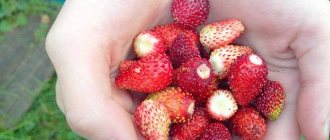Almost any supermarket now has a huge selection of seasonal fruits and berries. But, perhaps, even avid homebodies will agree that the product from the store shelf cannot be compared with the natural gifts of the forest. Strawberries deserve special attention - very aromatic, sweet, they will leave few people indifferent. In order to please yourself or your loved ones with a healthy and tasty berry, you need to know when wild strawberries ripen in the forest, as well as what to consider when harvesting them.
Where does it grow and what does it look like?
Strawberries grow throughout the entire former Soviet Union. The largest number of berries can be found in Eastern and Western Siberia, the central regions of Russia, the Moscow region, Kaluga, Novosibirsk, Tula, Lipetsk, Voronezh and Orenburg regions.
Wild strawberries are divided into three varieties:
- Forest - as is clear from its name, this berry can be collected on the edges of spruce and pine forests, forest clearings. Ripens in the second half of June, fruiting period is up to 4 weeks.
- Meadow - most often this berry can be seen in spacious clearings and meadows. Meadow strawberries are distinguished by their round berries and dark red color. It is well stored and does not deteriorate during transportation.
- Field - grows on the edges of deciduous forests, clearings and hay meadows. In central Russia, wild strawberries are harvested already in the first half of July. Fruiting duration is up to 20-25 days.
Note: Wild strawberries have a very soft and delicate consistency, so they cannot be stored or transported for a long time. Ripe berries should be eaten immediately or used for making jam, marmalade, marmalade and other winter preparations.
General information about the plant and its beneficial properties
Wild strawberries ripen throughout the entire European part of Russia, the Baltic states, Ukraine, Belarus, Kazakhstan, the Caucasus and Siberia. Grows in light forests, on sunny edges, among bushes or log houses.
Wild strawberries are rich in beneficial components that have a positive effect on the body:
- the leaves of the plant contain a high content of flavonoids, glycosides, catechins, minerals (potassium, cobalt, iron, bromine, calcium, copper, magnesium, chromium, iron, iodine, zinc, manganese, nickel, cobalt), organic acids;
- the flowers contain rutin, a substance with high vitamin activity;
- fruits contain vitamins, organic acids, pectins, natural sugars, tannins, macro- and microelements.
The complex of useful substances provides diaphoretic, diuretic, anti-inflammatory, vasodilating, tonic, and restorative effects.
The difference between wild and garden strawberries
You can even plant wild strawberry bushes on your own plot. If the plant takes root successfully, then it will be possible to start picking such berries earlier - wild strawberries ripen a little later due to the more shaded area.
Note! There are also “domesticated” garden strawberries. Its fruits are larger and very aromatic, but the beneficial components have less biological activity and, accordingly, bring less benefit to the body.
Maturation period
In what month strawberries begin to bloom depends on the region where they grow. In the Moscow region, the flowering of the plant begins in the second half of May. In the northern regions - in early June.
The flowering period lasts up to 6-8 days, after which berries form on the bush. When deciding when to pick ripe strawberries, you need to take into account that it takes 20 to 30 days for the berries to fully ripen.
Strawberries begin to ripen gradually, and not simultaneously, due to which the harvesting period also lasts up to 30 days
Strawberry - a symbol of summer
Strawberries are a summer berry. The fruits begin to ripen in mid-June, and in July the berries gain more juice and become juicier and red.
It is better to pick strawberries in the morning or evening, when the summer heat has subsided. If you pick berries during the heat, they will disappear very quickly.
If the summer turns out to be hot, the fruit ripening interval will be sharply reduced, and the opportunity to pick up sweet berries will disappear. From the heat, strawberries quickly deteriorate and begin to rot.
When to collect depending on region
When to pick strawberries depends on the weather and climatic conditions of the specific region where they grow. In the central regions of Russia, berry picking can begin in June or early July. The further north the region is located, the later the berries ripen. Residents of Siberia collect strawberries in the forests and fields until the end of August.
In the south of the country, strawberries will ripen much earlier - in the last weeks of May. Ripe berries can be picked until the end of June.
When strawberries are harvested in different regions:
| Region | Ripening time |
| St. Petersburg and Leningrad region | from June 28-30 (berries are available throughout July) |
| Yaroslavl, Novgorod, Ivanovo and Tver regions | From June 20-25 |
| In the Urals | Last days of June or early July |
| Moscow region | From June 20-25 |
| Orenburg region | From June 20-25 |
| Kaluga, Ryazan, Smolensk regions | From June 20-25 |
| Voronezh region | From June 15-18 |
| Saratov region | In the first half of June |
Note: We can conclude that in the southern regions you can start picking strawberries at the end of May or from the first days of June in the northern regions - throughout July. In this case, strawberry flowers and leaves used for tea are collected during the flowering period of the plant, before the berries ripen.
Distribution area
To begin with, we should say a few words about climatic zones. So that residents of Africa or, for example, Australia do not fool themselves with the question of where strawberries grow. They, as science says, are deprived of the opportunity to enjoy fresh wild berries. However, in artificial conditions, if they so desire, they can breed it. You know, the question of where strawberries grow looks tricky from this point of view. There is a very simple answer: in a greenhouse. Say so, you won’t be wrong. But you and I are interested in something else. The baskets are ready, a bus ticket to the forest has been purchased. What to do there is still unknown. Residents of Eurasia and America should look for strawberries with a reasonable hope of success of the operation. That is, you see that the distribution zone of this plant is wide. Both in Europe and Asia you can look for it in clearings and meadows. It is also collected in South and North America. It is believed that the sweetest and largest berries are hidden in shady areas. However, the forest is big. How to find the treasured clearing in it?
Features of collection
The duration of strawberry fruiting depends on several factors. With prolonged drought, the fruiting period is rapidly shortened, the berries quickly wither and spoil. Therefore, in the heat, you should not hesitate to go to the forest.
It is advisable to pick strawberries early in the morning - this will increase their shelf life, and midges and other insects will not bother you while picking the berries.
The fruits must be carefully inspected before harvesting. They should be completely red. Green tips indicate that the strawberries are not yet ripe. If the berries are too soft, they are overripe
Collection container
Strawberries are a very delicate and fragile berry that is harvested exclusively by hand. Its collection is quite labor-intensive. To prevent it from leaking juice immediately after being removed from the bush, it can be placed in low plastic bowls.
For collection, it is most convenient to use plastic containers with ventilation holes. With their help, you can monitor the condition of the collected fruits - as soon as drops of juice appear in the holes, the container is already completely filled.
For this purpose, you can use ordinary plastic baking containers, having previously made 15-25 holes in them. It is advisable to take several of these containers.
Since the collected strawberry fruits quickly deform and begin to drain juice, the following containers are not used for collecting them:
- glass bowls and jars;
- metal cans;
- galvanized and aluminum buckets.
An ordinary wicker basket is a good option for carefully and delicately picking strawberries. Such containers do not compress the fruits and provide them with natural ventilation
Collection rules
One of the main conditions for properly harvesting strawberries is picking ripe fruits along with green calyxes. That is why the process of harvesting wild fruits is long and labor-intensive.
Basic collection rules:
When can you collect pine cones for jam?
- Berries should be picked only in dry and warm weather. Drops of rain or dew on the fruits will lead to their rapid spoilage and rotting.
- When harvesting for jam or preserves, it is better to pick the berries in small armfuls. This will significantly reduce collection time.
- The fruits must be picked very carefully and carefully. Strawberries have a fragile and sensitive root system and with strong pressure you can easily tear out the entire plant.
- Strawberries cannot be compacted; they are placed in a container in no more than 2-3 layers.
- If it starts to rain while picking or transporting strawberries, the collected berries should be spread out in an even layer in a cool room and left until completely dry.
Strawberries are picked by hand. Many farmers and gardeners use scissors to harvest, carefully cutting off the berry with a long tail or cutting it off at the very base. This method is quite effective, since the cut berries do not leak juice and are not deformed.
If the harvested crop will be used for making preserves and marmalade and will undergo heat treatment, you can use special fruit harvesters.
What to cook from the collected berries?
Having picked a lot of strawberries and eaten enough, the question arises of what to do with the remaining berries so that they don’t go to waste. First, you need to sort the berries, tear off the “tails” from them and wash them. And then from strawberries you can prepare many different delicacies that will remind you of summer in winter frosts.
- The very first strawberry delicacy that first comes to mind is jam. The cooking process is somewhat labor-intensive, but what a pleasure it will be afterwards. And the benefits will be no less. Strawberry jam is an excellent remedy for colds.
- Strawberry sauce is another sweet option made from berries. But, unlike jam, the sauce does not need to be boiled, but simply beat the berries, sugar and vanilla in a blender, and cool everything. This sauce would be a great addition to ice cream or baked goods.
- From the collected aromatic fruits you can cook fresh compote. And if you dry the berries, then even in winter you can enjoy a “piece” of summer, in the form of a compote or an additive to tea.
- Strawberries can be a sweet ingredient in baked goods. You can make strawberry pie, buns or roll.
- You can cook berry syrup.
- Washed and sorted berries can simply be frozen, and in winter you can take them out and prepare a fragrant pie from them or make a fruit drink.
As you can see, a lot of things can be prepared from strawberry fruits. The main thing is not to leave fresh berries unused, otherwise all the work of picking will be lost. And it will be a pity for the fruits, because they contain many vitamins and other useful substances that do not disappear even when cooked.
Harvesters for harvesting
Convenient harvester-harvesters designed for harvesting can be purchased in specialized stores for gardeners and vegetable gardeners. They greatly simplify and speed up fruit harvesting.
There are two types of berry harvesters:
- Manual - primitive devices. Outwardly, they resemble a small box with “teeth”, with the help of which berries are picked from a branch.
- Mechanical - the principle of operation of such devices is reminiscent of a grain harvester with a fully automated fruit harvesting process. Most often, such devices are used on large farms with large-scale berry plantations.
When choosing a small hand harvester from a gardening store, you need to pay attention to the size of the tines. For strawberries that are small in size, devices with gaps of up to 6 mm between the cloves are best suited. Such harvesters will pass through leaves and branches well, “collecting” the berries in a box.
To harvest strawberries, you cannot use devices with too many teeth, as they cause serious damage to the desired bushes, reducing their yield for several years. That is why such harvesters are considered poaching, and their use is punishable by fines.
Growing rules
Cultivating meadow strawberries is not difficult: they are unpretentious and can grow even in slight shade. The best predecessors of berries are cabbage and legumes, lettuce, garlic, onions, carrots, and beets.
Whiskers are used to propagate strawberries.
Planting is carried out both in spring and autumn, in a row, maintaining a distance of 60-70 cm between rows and 15-20 cm between bushes.
The soil must be cleared of weeds in advance. It is advisable to place the plantings on a hill where it will receive maximum sunlight. If the groundwater level is high, there is a risk of developing root diseases, so growing in beds is recommended.
Caring for meadow strawberries is standard and consists of watering and fertilizing, which are especially important during the flowering and ripening phases of the berry, as well as after harvesting. It is recommended to use complex fertilizers such as Zdraven, Kemira-Lux and Ideal.
: they have a positive effect on the yield and quality characteristics of berries.
Ripe meadow strawberries are widely used for making jam, desserts, baking, freezing and drying.
Answers on questions
How to store the harvested strawberries are perishable berries. If storage rules are not followed, the fruits quickly lose their marketability and taste. It is for this reason that strawberries cannot be washed after picking, and soft brushes are used to remove debris.
Rules for storing strawberries:
- Go through the collected fruits - remove all rotten, softened fruits, as well as all specimens with traces of mold. One such berry can lead to rapid spoilage of the entire harvest.
- Strawberries can be stored in a plastic container with ventilation holes for no more than 2 days. In a wicker basket, fruits are preserved much better and longer.
- Plastic containers lined with paper napkins are used to store strawberries. The optimal temperature is from 0°C to +2°C. In such conditions, the berries will last up to 5-7 days. The higher the air temperature, the shorter the shelf life of strawberries.
How long can crops be stored fresh? Strawberries do not last long. It is advisable to start processing on the day of collection. Leave in the refrigerator for a maximum of 2 days. Longer storage is possible only in frozen form.
Description
I found another strawberry - common strawberry. It is easily distinguished from green strawberries: ALL of its leaves are sessile or almost sessile, at least the same; the petals do not overlap each other with their edges, and the sepals are bent when the fruits are present. In principle, the flowers of strawberry and blackberry are somewhat similar to strawberry flowers, but we know that they (strawberry and blackberry) are prickly! In addition, their flowers do not have a cup.
Flowers
Cup with cup. The sepals of the calyx are lanceolate, with a narrowed pointed point; The sepals of the subcup are lanceolate, somewhat longer than the sepals of the calyx, and approximately equal in width.
The peduncles are pubescent with pressed hairs directed upward (that is, “from below” - from the root and “up” - to the flower and fruit. If this is not taken into account, then with bent fruits it seems that the hairs are directed downward, and this is a different look).
Leaves
The leaves are trifoliate, broadly triangular at the apex.
The lateral leaves are obliquely ovate.
The lateral leaves are all almost sessile, the size of the petiole is the same in all.
The leaves are oval-rhombic or oval.
Leaves with 6-10 large triangular or semi-ovate teeth.
The petiole of the basal leaf is densely pubescent.
Stem
The stem is up to 25 cm high, slightly higher than the leaves.
A perennial with a short rhizome and numerous rooting shoots - tendrils. Stems are densely pubescent.
The “fruit” is ovoid, up to 2 cm long
In fact, this is not a fruit, but an overgrown receptacle, which filled with sweetness, turned red and began to attract our and not only our attention
Unlike green strawberries, common strawberries have sepals and subcup leaves that are bent away from the “fruit.”
Application
The berries are edible. I’ll say this: wild strawberries will give 100,500 points a head start over cultivated strawberries in terms of taste. Strawberry leaves can be brewed into herbal tea.
